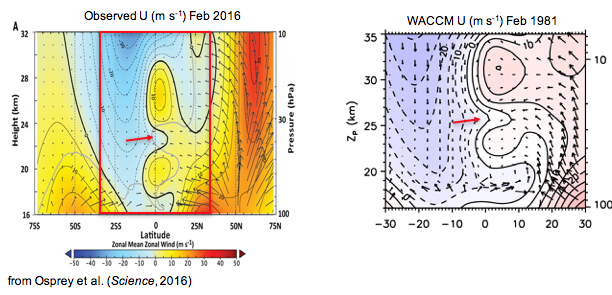3B: WACCM model development
ACOM scientists have continued to develop the WACCM model in preparation for the release of CESM2.0 and CMIP6. Model advances include doubling the horizontal model resolution to ~1˚ in latitude and longitude and unifying model physics with the latest pre-release version of CAM. Model chemistry has been updated to significantly improve the handling of VOCs and secondary organic aerosols.
As reported in the 2016, a high-resolution version of WACCM has been developed by J. Richter (CGD) and R. Garcia (ACOM). This version is based upon the standard version of WACCM, but with a vertical grid of 110 levels (110L) that provides very high vertical resolution (500 m) between the boundary layer and the middle stratosphere. Adding this resolution enables WACCM to produce an internally-generated quasi-biennial oscillation (QBO) in the tropical stratospheric zonal mean wind. The figure below pertains to the observation of a very unusual pattern in the tropical lower stratospheric zonal wind (red arrow in left panel). For the first time in the observation record, there was an “interruption” of the QBO in February 2016. By using the 110L version of WACCM, Richter and Garcia have recently identified a similar pattern in that simulation (right panel), providing the first model analysis of this unusual behavior. In both panels (black arrows indicate momentum transport). Examination of the momentum budget (not shown) indicates that, in the model, that planetary-scale Rossby waves propagating from the northern (winter) hemisphere initiate the interruption. This is consistent with the Osprey et al. findings and therefore provide an indication that the model is representing the necessary processes realistically.

Contact
Please direct questions/comments about this page to:
Carl Drews
NSF NCAR | Research IT | ACOM